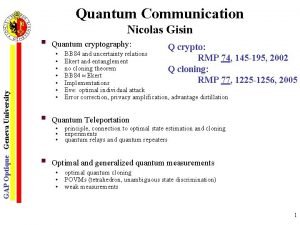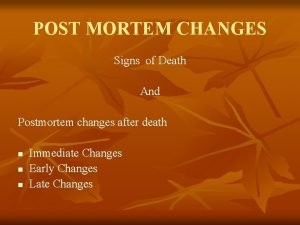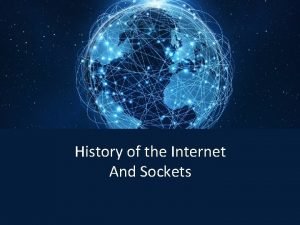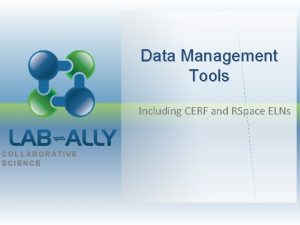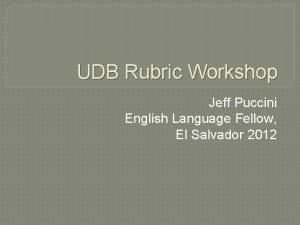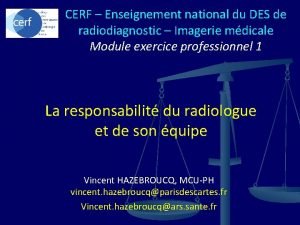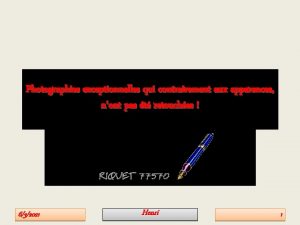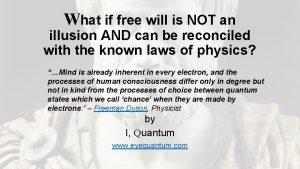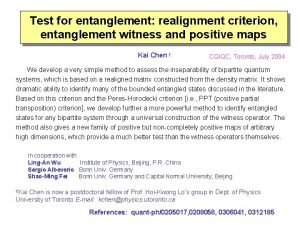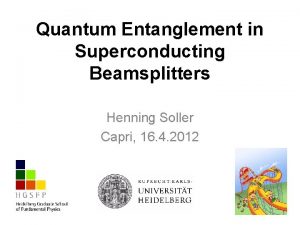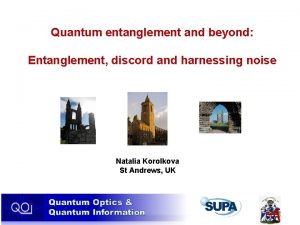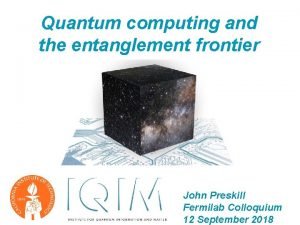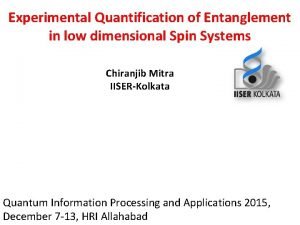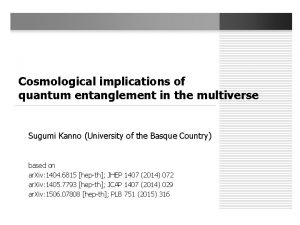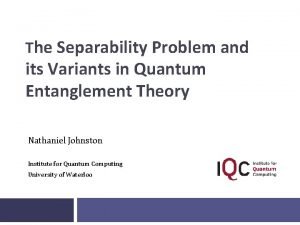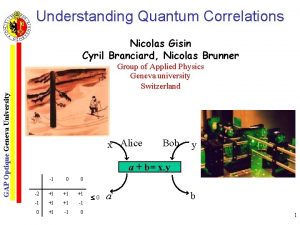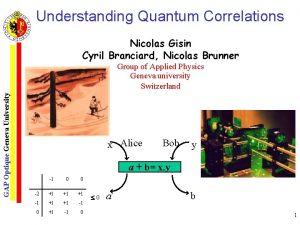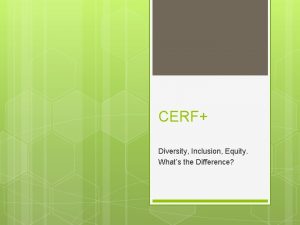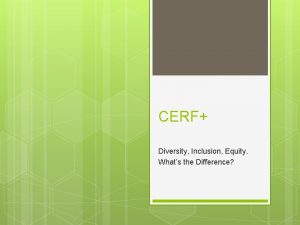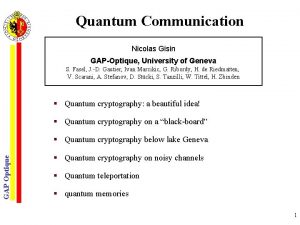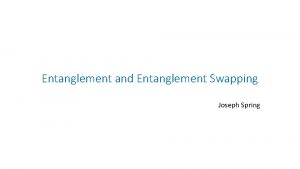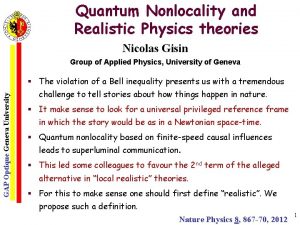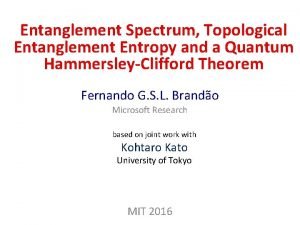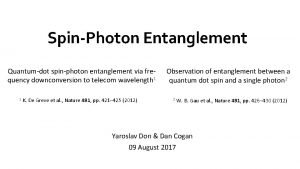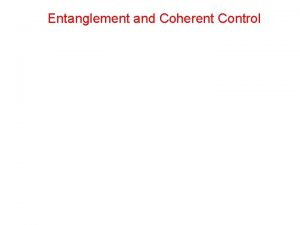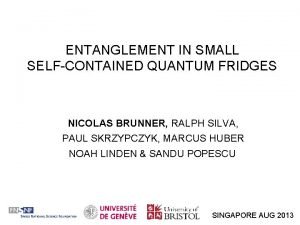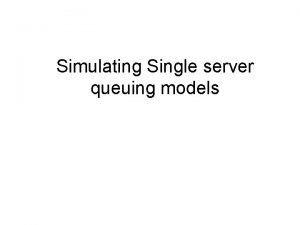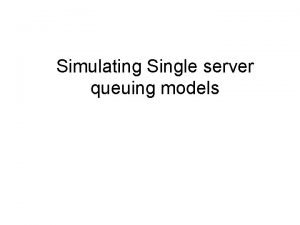Simulating entanglement without communication Nicolas Gisin Nicolas Cerf




















- Slides: 20

Simulating entanglement without communication Nicolas Gisin Nicolas Cerf, Serge Massar, Sandu Popescu GAP Optique Geneva University Group of Applied Physics, University of Geneva § Simulating entanglement with a few bits of communication § How strong can no-signaling correlation be? § The PR nonlocal machine § Simulating entanglement with the nonlocal machine § Is Nature sparing with resources? § CHSH-Bell and the PR machines are monogamous § Bell inequality with more settings, combined PR machines § Is partial entanglement more non-local? 1

Simulating entanglement with a few bits of communication (+ shared randomnes) GAP Optique Geneva University & define measurement bases The output & should reproduce the Q statistics: Alice Bob Case of singlet: 8 bits, Brassard, Cleve, Tapp, PRL 83, 1874 1999 2 bits, Steiner, Phys. Lett. A 270, 239 2000, Gisins Phys. Lett. A 260, 323, 1999 1 bit! Toner & Bacon, PRL 91, 187904, 2003 0 bit: impossible (Bell inequality) … but … 2

How strong can no-signaling correlation be? GAP Optique Geneva University CHSH-Bell inequality: 1) Q correlation can violate Bell inequalities, but can’t be used for signaling 2) Q correlation can’t violate the CHSH-Bell inequality By more than a factor Are these two facts related? Could there be correlations that: 1) Do not allow signaling, and 2) Do violate the CHSH inequality by more than ? Answer: yes! S. Popescu and D. Rohrlich, quant-ph/979026. 3

The nonlocal Machine x Alice Bob y GAP Optique Geneva University Non local Machine a a + b= x. y b E(a=1|x, y) = ½, independent of y no signaling E(a, b|0, 0) + E(a, b|0, 1) + E(a, b|1, 0) - E(a, b|1, 1) = 4 4

The nonlocal Machine x Alice Bob y GAP Optique Geneva University Non local Machine a a + b= x. y b A single bit of communication suffice to simulate the NL Machine (assuming shared randomness). But the NL Machine does not allow any communication. Hence, the NL Machine is a strickly weaker ressource than communication. 5

Simulating singlets with the NL Machine Bob GAP Optique Geneva University Alice Non local Machine a Given b & , the statistics of & is that of the singlet state: 6

GAP Optique Geneva University Is Nature sparing with resources? 7

The CHSH-Bell inequality is monogamous Theorem: For all 3 -qubit state ABC, If A-B violates the CHSH-Bell inequality then neither A-C nor B-C violates it. GAP Optique Geneva University A B C (see V. Scarani & NG, PRL 87, 117901, 2001, see also B. Therhal et al. , PRL 90, 157903, 2003) 8

Causal nonlocal machines are monogamous x hi ac l. M ca lo y a loc al z M ac h ine No n GAP Optique Geneva University ne No n b If c a+b=x. y then b+c=x(y+z), and Alice can signal to B-C a+c=x. z 9

The new inequality for qubits with 3 settings GAP Optique Geneva University This is the only new inequality for 3 inputs and binary outputs. D. Collins et al. , J. Phys. A 37, 1775 -1787, 2004 I 3322=P(a=0, b=0|x=0, y=0)+P(0, 0|0, 1)+P(0, 0|0, 2) + P(0, 0|1, 0)+P(0, 0|1, 1)-P(0, 0|1, 2) + P(0, 0|2, 0)-P(0, 0|2, 1) - P(a=0|x=0) – 2 P(b=0|y=0) – P(b=0|y=1) 0 10

For each , let CHSH be the critical weight such that ( )= CHSH Pcos( )|00>+sin( )|11> + (1 - CHSH) P|01> is at the limit of violating the CHSH inequality 1. 03 1. 01 1. 00 trace(Br) GAP Optique Geneva University 1. 02 0. 99 0. 98 0. 97 0. 96 0. 95 0. 0 0. 2 0. 4 0. 6 0. 8 1. 0 1. 2 1. 4 1. 6 q 11

The I 3322 -Bell inequality is not monogamous There exists a 3 -qubit state ABC, such that A-B violates the I 3322 -Bell inequality and A-C violates it also. GAP Optique Geneva University A ABC B C (see D. Collins et al. , J. Phys. A 37, 1775 -1787, 2004) 12

The nonlocal machine optimal for the I 3322 Bell inequality x Alice Bob GAP Optique Geneva University x=x 1 x 2 y y=y 2 y 1 Non local Machine a 1 b 1 Non local Machine a 2 = 1+ 2 b=b 1 + b 2 13

22 ine Ma ch >0 Ma ine ch >0 I 33 al loc al oc 22 No n nl I 33 B A No GAP Optique Geneva University The NL Machine I 3322 is not monogamous C 14

Simulating partial entanglement GAP Optique Geneva University Partially entangled states seem more nonlocal than the max entangled ones ! Nonlocality entanglement 15

GAP Optique Geneva University Conclusions § One can simulate the singlet Q correlations with qualitatively less than a bit of communication. § Causal (ie no signaling) correlation can be stronger than the Q correlation. § The NL Machine inspired by the CHSH-Bell inequality suffice to simulate singlet correlation, (one instance of the NL Machine per simulated outcome). § Is Nature sparing with resources? § CHSH-Bell inequality and the NL Machine are monogamous, but the inequality with 3 settings per site is not. § The NL Machine corresponding to the new Bell inequality contains 2 elementary NL machines, “explaining” why it is not monogamous. 16

GAP Optique Geneva University 1 2 17

GAP Optique Geneva University x=0 x=1 x=0 18

GAP Optique Geneva University (0, 0) (1, 0) (0, 1) (1, 1) (0, 1) (1, 0) (0, 0) 19

A=a+1 B=b GAP Optique Geneva University (0, 0) (1, 0) (0, 1) (1, 1) (0, 1) (1, 0) (0, 0) B=b+1 A=a 20
 Gap optique
Gap optique Cadaveric spasm and rigor mortis difference
Cadaveric spasm and rigor mortis difference Postmortem signs
Postmortem signs Leonard kleinrock
Leonard kleinrock Rspace eln
Rspace eln Jeff puccini
Jeff puccini Réaction du cerf à la balle
Réaction du cerf à la balle Cerf radiologie évaluation
Cerf radiologie évaluation Cerf volant baleine
Cerf volant baleine Quadrilatre
Quadrilatre What is time
What is time Firefighter maze plans
Firefighter maze plans Entanglement witness
Entanglement witness Entanglement strategy
Entanglement strategy Entanglement
Entanglement Discord
Discord Quantum computing and the entanglement frontier
Quantum computing and the entanglement frontier Quantum discord
Quantum discord Chiranjib mitra iiser kolkata
Chiranjib mitra iiser kolkata Implications of quantum entanglement
Implications of quantum entanglement Quantum entanglement
Quantum entanglement
